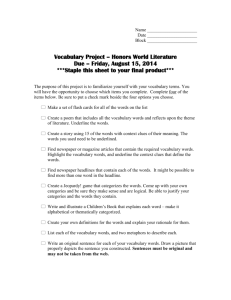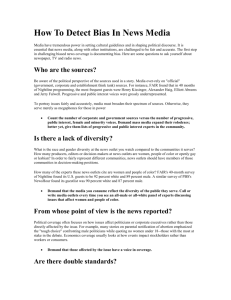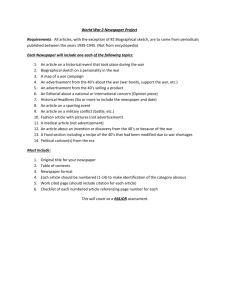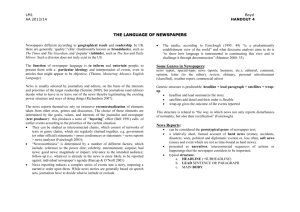Teacher notes and student sheets
advertisement
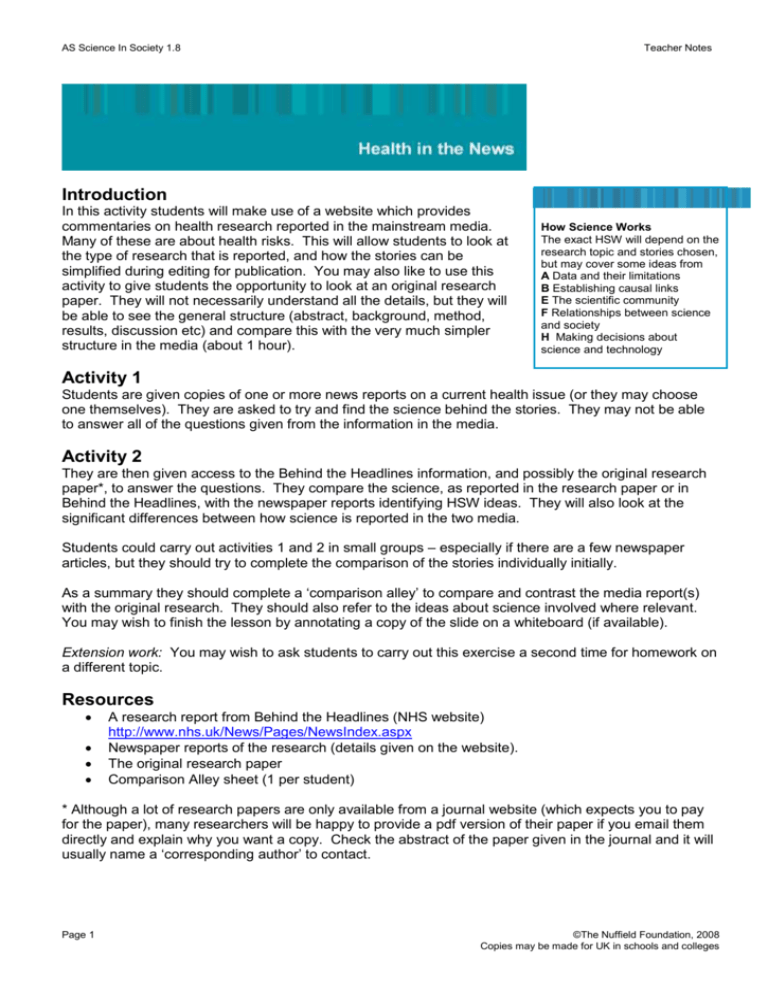
AS Science In Society 1.8 Teacher Notes Introduction In this activity students will make use of a website which provides commentaries on health research reported in the mainstream media. Many of these are about health risks. This will allow students to look at the type of research that is reported, and how the stories can be simplified during editing for publication. You may also like to use this activity to give students the opportunity to look at an original research paper. They will not necessarily understand all the details, but they will be able to see the general structure (abstract, background, method, results, discussion etc) and compare this with the very much simpler structure in the media (about 1 hour). How Science Works The exact HSW will depend on the research topic and stories chosen, but may cover some ideas from A Data and their limitations B Establishing causal links E The scientific community F Relationships between science and society H Making decisions about science and technology Activity 1 Students are given copies of one or more news reports on a current health issue (or they may choose one themselves). They are asked to try and find the science behind the stories. They may not be able to answer all of the questions given from the information in the media. Activity 2 They are then given access to the Behind the Headlines information, and possibly the original research paper*, to answer the questions. They compare the science, as reported in the research paper or in Behind the Headlines, with the newspaper reports identifying HSW ideas. They will also look at the significant differences between how science is reported in the two media. Students could carry out activities 1 and 2 in small groups – especially if there are a few newspaper articles, but they should try to complete the comparison of the stories individually initially. As a summary they should complete a ‘comparison alley’ to compare and contrast the media report(s) with the original research. They should also refer to the ideas about science involved where relevant. You may wish to finish the lesson by annotating a copy of the slide on a whiteboard (if available). Extension work: You may wish to ask students to carry out this exercise a second time for homework on a different topic. Resources A research report from Behind the Headlines (NHS website) http://www.nhs.uk/News/Pages/NewsIndex.aspx Newspaper reports of the research (details given on the website). The original research paper Comparison Alley sheet (1 per student) * Although a lot of research papers are only available from a journal website (which expects you to pay for the paper), many researchers will be happy to provide a pdf version of their paper if you email them directly and explain why you want a copy. Check the abstract of the paper given in the journal and it will usually name a ‘corresponding author’ to contact. Page 1 ©The Nuffield Foundation, 2008 Copies may be made for UK in schools and colleges AS Science In Society 1.8 Teacher Notes As an example: Story: Mediterranean diet cuts risk of Cancer. Behind the headlines: http://www.nhs.uk/news/2008/07July/Pages/Mediterraneandietcutscancerrisk.aspx Newspaper reports can be found on the ‘Behind the Headlines’ webpage and are from the Independent, Daily Express, The Daily Telegraph and BBC News. Original paper: http://www.nature.com/bjc/journal/v99/n1/pdf/6604418a.pdf October 2008 Page 2 ©The Nuffield Foundation, 2008 Copies may be made for UK in schools and colleges AS Science In Society 1.8 Student sheets Introduction Newspapers often report the results of scientific research. However, the story that is printed in the paper is often quite different from the original research published in a scientific journal. In this activity you will compare the two. Activity 1 Your teacher will give you copies of some newspaper reports about a piece of scientific research. Read through them. Are there any differences in how the story is reported in different newspapers? Why do you think this is? Now in small groups try to find answers to the following questions: 1. Who carried out the research and where are they based? 2. What sort of study did they carry out? a. How many subjects took part? b. What different conditions were tested? c. Were there any controls used? d. Who funded the research? e. Were there any possible conflicts of interest? 3. What were the main findings of the research? 4. What are the consequences of the research for the general public? 5. What sort of style and language are used to report the research? 6. Are there any limitations to the study carried out? Activity 2 You will now be given commentary on the research paper, provided by the NHS, and possibly the original research paper. Read through these new articles and try to use them to answer the questions above again. You should now find much more information. Read through the articles again, and this time highlight any places where ideas about how science works are made use of. These may be taken from the following sections: A: Data and their limitations, B: Establishing Causal links, E: The scientific community, F: Relationships between science and society, and H: Making decisions about science and technology Summary activity Use the Comparison Alley graphic organiser to compare and contrast the two types of article you have read: scientific research papers (or NHS commentary) and newspaper reports. Try and add as much detail as you can, including the ideas about science you have identified in Activity 2. Page 3 ©The Nuffield Foundation, 2008 Copies may be made for UK in schools and colleges AS Science In Society 1.8 Student sheets Comparison Alley Journal paper: . . . . . . .... Compare/Contrast .. Differences Differences Similarities Page 1 Newspaper(s): . . . . . . . . ... ©The Nuffield Foundation, 2008 Copies may be made for UK in schools and colleges
